Many museums have explored the history of nuclear science, technology, and politics. These museums vary greatly in geographical location, size, and scope. Some are dedicated solely to the historic preservation and interpretation of some aspect of the atomic age. Others have different areas of specialty but have chosen to feature nuclear history as it relates to their primary topic. One thing these diverse institutions do share, however, is the goal of engaging the public with this complex and polarizing history.
Due to the many controversial and complicated aspects of nuclear history, pursuing this goal often presents challenges. For example, museums in the United States tend to offer America-centric perspectives, sometimes leaving out international or minority voices involved with or affected by nuclear weapons and technology. Many museums attend to their local histories, not necessarily capturing the national or international scope of nuclear weapons and energy.
Scholars and nuclear non-proliferation groups frequently criticize museums for prioritizing one side of the story, often ignoring the stories of people harmed by radiation exposure or nuclear weapons production. Consequences of Radiation Exposure (CORE), a nonprofit in Washington State, is working to “found an international museum focusing upon issues relating to the health effects of ionizing radiation,” so it is possible that this issue will begin to receive more attention.
As it develops its interpretive plan, the recently-established Manhattan Project National Historical Park will have to contend with the many complex issues of nuclear history in its partnerships with local institutions at Oak Ridge, Hanford, and Los Alamos.
Below is a guide to museums that feature, or have in the past featured, nuclear history. The museums are organized geographically by country or state, and then alphabetically within a given location.
If you are interested in nuclear history museums, you may want to check out AHF’s “Ranger in Your Pocket” website. “Ranger in Your Pocket” offers online interpretive programs on Manhattan Project sites, featuring audiovisual vignettes drawn from interviews with Manhattan Project veterans and their families.
Japan
Hiroshima Peace Memorial Museum
Permanent Exhibits


The Hiroshima Peace Memorial Museum opened in 1955 as part of the Hiroshima Peace Memorial Park. The museum documents the atomic bombing of Hiroshima on August 6, 1945 by the United States, and it receives over one million visitors per year on average. One of the Musuem’s goals is to express the “horrors and inhumane nature of nuclear weapons” through video testimonies of survivors as well as displays of objects and belongings that remained after the bombing.
The Hiroshima Peace Memorial Museum features rotating temporary special exhibitions. Past exhibitions have included “War through the Eyes of Children,” “Filming in the Ruins,” and “A-bombed Structures Speak.” The museum also holds special events, such as talks with survivors of the bombings, or hibakusha.
The Schmoe House serves as an annex building for the museum. Named for Floyd Schmoe, an American who started a project to build houses in Hiroshima after the atomic bombing, the Schmoe House “displays stories about the support that Hiroshima received from overseas after the atomic bombing.”
In addition to the museum, the Hiroshima Peace Memorial Park contains a number of outdoor monuments devoted to the memory of atomic bomb victims and the promotion of world peace. The Memorial Cenotaph, pictured to the right, was built in 1952 and holds the names of all people killed by the bomb. Other monuments include the Peace Flame, the Peace Bells, the Atomic Memorial Mound, the Cenotaph for Korean Victims, the Gates of Peace, and the Memorial Tower to the Mobilized Students.
Nagasaki Atomic Bomb Museum
Permanent Exhibits
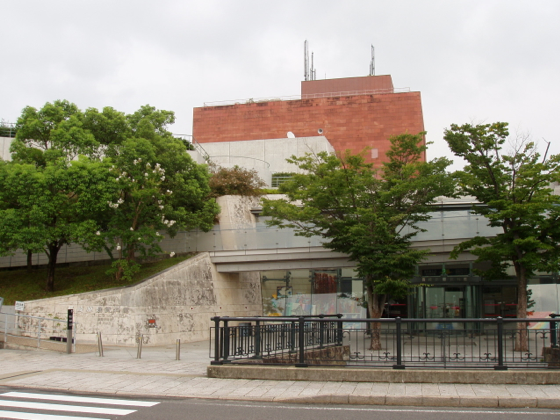 Part of the Nagasaki Peace Park, the Nagasaki Atomic Bomb Museum was founded in 1955 before moving to its current location in 1996. The museum covers the history of the United States’ atomic bombing of Nagasaki on August 9, 1945 and its aftermath. Like the Hiroshima Peace Memorial Museum, the Nagasaki Atomic Bomb Museum displays objects that were damaged in the bombings and video testimonies by survivors. The museum actively promotes world peace and nuclear non-proliferation.
Part of the Nagasaki Peace Park, the Nagasaki Atomic Bomb Museum was founded in 1955 before moving to its current location in 1996. The museum covers the history of the United States’ atomic bombing of Nagasaki on August 9, 1945 and its aftermath. Like the Hiroshima Peace Memorial Museum, the Nagasaki Atomic Bomb Museum displays objects that were damaged in the bombings and video testimonies by survivors. The museum actively promotes world peace and nuclear non-proliferation.

The exhibits are laid out chronologically. The first exhibit portrays Nagasaki just before the bombing, focusing on daily life and its shipbuilding industry. Then, visitors proceed to an exhibit on the damage caused by the bomb, before finishing with a display that considers the subsequent history of nuclear weapons throughout the twentieth century up to today.
Next to the Museum are the Nagasaki Peace Park and the Nagasaki National Peace Memorial for the Atomic Bomb Victims. The Park includes the Peace Statue (pictured at right) and the Fountain of Peace, while the Memorial Hall offers a place to remember and pray for the atomic bomb victims.
United States
Illinois
Museum of Science and Industry
Temporary Exhibit: 2017-2018
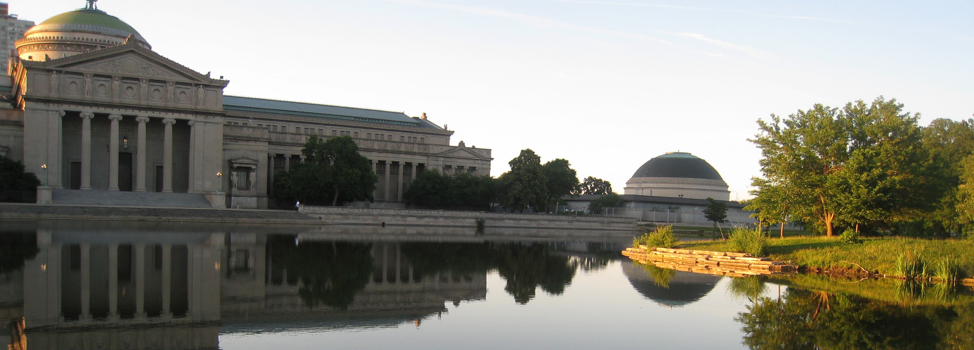
The Museum of Science and Industry (MSI) in Chicago opened in 1933. The largest science museum in the Western Hemisphere, the MSI resides in a building from the 1893 World’s Fair. Home to more than 400,000 square feet of exhibits and more than 35,000 artifacts, the Museum of Science and Industry seeks “to build public understanding of science, show how science impacts our society and inspire everyone to think critically about the world around us.” 1.5 million people visited the museum in 2017.
In partnership with the Bulletin of the Atomic Scientists, MSI debuted a new temporary exhibit in 2017 called Turn Back the Clock. The exhibit focused on the seventy-year history of the Bulletin’s Doomsday Clock, a twentieth-century icon and symbol of the existential threats humanity faces. Turn Back the Clock explored the roots of the Doomsday Clock in the Atomic Age, including an exploration of atomic popular culture and a timeline of the nuclear age, while also examining other twenty-first century challenges such as climate change.
Louisiana
The National World War II Museum
Permanent Exhibits
The National World War II Museum, located on a six-acre campus in New Orleans, chronicles the American experience in the Second World War. The museum was established in 2000 and is an affiliate of the Smithsonian Institution. The museum offers an expansive range of programs and resources: lectures, conferences and symposia, film screenings, travel programs, family-oriented events, professional development programs for teachers, online educational materials, and special WWII commemorative events
The museum is also home to the Institute for the Study of War and Democracy, which is “a community of scholars forming a national center for research, higher education, publications, and public programming, dedicated to promoting the history of World War II, the relationship between the war and America’s democratic system, and the war’s continued relevance for the world.”
The museum’s permanent exhibits include Road to Tokyo and Road to Berlin, which detail American involvement in the Pacific and European theaters of WWII, respectively. The museum’s most recent permanent exhibit, The Arsenal of Democracy, tells the story of the U.S. Home Front during the war. This exhibit includes various galleries, such as “War Affects Every Home,” an immersive gallery depicting a 1942-style home, and “Manufacturing Victory,” which focuses on the role of American industry in the war effort. The final gallery in The Arsenal of Democracy is “The Manhattan Project.” This gallery chronicles the way this massive mobilization project affected the lives of the leading scientists and everyday Americans who worked on the bomb, as well as the atomic bomb’s role in the war.
Nevada
National Atomic Testing Museum
Permanent Exhibits

The National Atomic Testing Museum (NATM), located in Las Vegas, focuses on the science and history of the nuclear weapons tests at the Nevada Test Site. Covering everything “from Atomic Age culture to the scientific and technological advances” of the Cold War, this museum holds 3,500 artifacts, 16,000 photographs, and a large collection of books and DVDs.
NATM features permanent exhibits on the development of the atomic bomb, the science of radiation, atmospheric testing of the bomb, underground testing, and atomic culture. Its current (2018) temporary exhibits highlight Operation Crossroads and include additional information on radiation science. A notable past exhibit was “Building Atomic Vegas,” which told the history of the construction of the Nevada Test Site and the development of the city of Las Vegas in the mid-twentieth century.
The museum coordinates field trips and offers free seminars on radiation science to students at the middle school level and up. NATM also hosts a lecture series with experts on nuclear science, technology, and policy. These videos are available on their YouTube channel. The museum also maintains an online collection of articles relating to nuclear history, policy, and current events.
New Mexico
Bradbury Science Museum
Permanent Exhibits
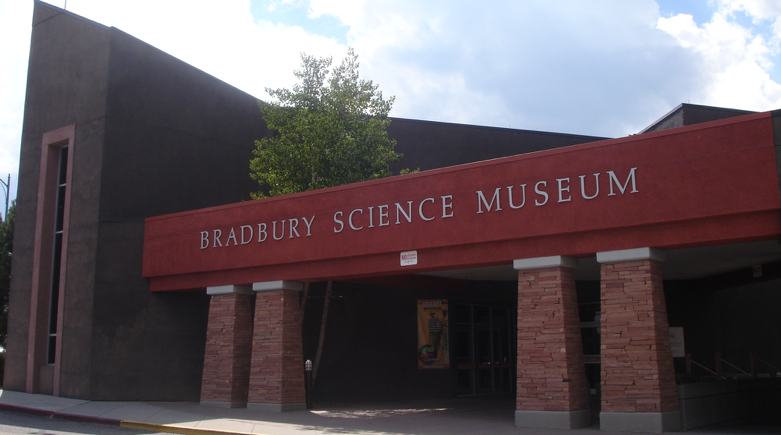 The Bradbury Science Museum in Los Alamos dates back to 1954. Named after Norris E. Bradbury, the second director of the Los Alamos National Laboratory, it was initially designated to preserve the history of the weapons program at the lab. Since then, the museum has expanded in scope to include the relationship of the research at Los Alamos to “national and international economic, environmental, political, and social concerns.” About 80,000 people visit the museum per year.
The Bradbury Science Museum in Los Alamos dates back to 1954. Named after Norris E. Bradbury, the second director of the Los Alamos National Laboratory, it was initially designated to preserve the history of the weapons program at the lab. Since then, the museum has expanded in scope to include the relationship of the research at Los Alamos to “national and international economic, environmental, political, and social concerns.” About 80,000 people visit the museum per year.
The Bradbury is home to a Defense Gallery and a History Gallery. The Defense Gallery focuses on the work of Los Alamos National Laboratory on the “safety, security, and reliability of the U.S. nuclear deterrent while reducing the global threat of nuclear, chemical, and biological weapons.” Some exhibits in this gallery are “Understanding Nuclear Weapons,” “Stockpile Stewardship,” and “History of Supercomputing at Los Alamos.” The History Gallery mostly features the Manhattan Project, with such exhibits as “The Atomic Age Timeline” and “They Changed the World: The People of Project Y at Los Alamos.”
The museum’s website has a variety of resources, including numerous video lectures, such as “Wartime Role of Oak Ridge,” “Enola Gay Pilot: A Grandfather Remembered,” and “Nuclear Weapons Testing During the Cold War.” The website also has a small sampling of educational pamphlets on topics relating to the Manhattan Project. The Bradbury Museum has even developed an interactive app, “Los Alamos: Secret City of the Manhattan Project,” available on iOS.
Los Alamos History Museum
Permanent Exhibits
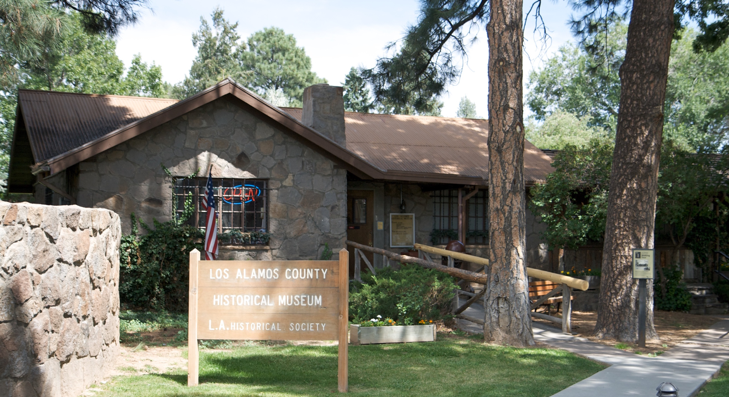 The Los Alamos History Museum is housed in a 1918 building that served as guest quarters for scientists and workers at Los Alamos during the Manhattan Project. Chronicling both recent and ancient history, the Los Alamos History Museum has exhibits on subjects ranging from regional geology and anthropology to the Manhattan Project.
The Los Alamos History Museum is housed in a 1918 building that served as guest quarters for scientists and workers at Los Alamos during the Manhattan Project. Chronicling both recent and ancient history, the Los Alamos History Museum has exhibits on subjects ranging from regional geology and anthropology to the Manhattan Project.
The museum offers docent-guided walking tours of the Los Alamos Historic District, including Bathtub Row, which housed prominent Manhattan Project physicists and their families during World War II. The Hans Bethe House on Bathtub Row is home to the museum’s Harold Agnew Cold War Gallery, focusing on Los Alamos—both the National Laboratory and the people in the local community—in the decades after the Manhattan Project.
The Los Alamos History Museum offers educational field trips and classroom visit outreach programs that address the history of Los Alamos in relation to nuclear science and other topics. In partnership with the Santa Fe Opera’s 2018 production of Doctor Atomic, the museum offered a variety of related events, including a special tour of Los Alamos, a talk on Dorothy McKibbin, and a temporary exhibit on J. Robert Oppenheimer’s life through photographs.
The Los Alamos History Museum is a longtime partner with the Atomic Heritage Foundation on various projects, including the joint oral history website, “Voices of the Manhattan Project.”
The National Museum of Nuclear Science and History
Permanent Exhibits
Located in Albuquerque, the National Museum of Nuclear Science and History was established in 1969. A Smithsonian affiliate, its goal is “to tell the story of the Atomic Age, from early research of nuclear development through today’s peaceful uses of the technology.” Approximately 60,000 people visit the museum each year.
The museum’s numerous exhibits cover topics including nuclear medicine, nuclear waste transportation, the Cold War, the bombings of Hiroshima and Nagasaki and their aftermaths, atomic culture, and pioneering nuclear scientists. One of its most popular attractions is Heritage Park, an outdoor collection of planes, rockets, missiles, and nuclear submarines. In 2018, the installation “Critical Assembly, the Secrets of Los Alamos 1944,” by American artist Jim Sanborn, opened as a permanent exhibit after previously having been on temporary display. “Critical Assembly” recreates the Manhattan Project scientists’ experiments at Los Alamos to determine when plutonium would go “critical” in an atomic bomb. Sanborn assembled the exhibition using a mix of authentic electronic equipment and original, recreated components.
The museum also offers a variety of programs, including a science summer camp and an annual bus tour to the Trinity Site. Their website also includes curricular materials for teachers on nuclear science and history.
New Mexico History Museum
Temporary Exhibits: June 2018-May 2019
The New Mexico History Museum in Santa Fe opened in 2009, with its mission “to tell New Mexico’s oldest stories, collect some of its oldest objects, and to preserve other cultural resources that represent the state’s centuries-long narrative.” It is located on a campus that also includes New Mexico’s famous Palace of the Governors, first constructed in the late 1600s.
“Atomic Histories: Remembering New Mexico’s Nuclear Past” opened at the museum in June 2018. The history of the Manhattan Project, including the research and creation of nuclear weapons in Los Alamos and the Trinity Test near Alamogordo, features prominently in the exhibit. Two mixed media installations related to the Manhattan Project by artist Meridel Rubinstein, The Meeting (1993) and Oppenheimer’s Chair (1995), are on display as well.
The exhibit highlights New Mexico’s nuclear history after World War II, such as the weapons research conducted at Los Alamos and Albuquerque, uranium mining in the Grants Mineral Belt, the Waste Isolation Pilot Project in Carlsbad, and the new uranium enrichment plant in Eunice. The exhibit will remain open until the end of May 2019.
White Sands Missile Range Museum
Permanent Exhibits
The White Sands Missile Range in New Mexico is home to the Trinity Site. The museum documents the history of the Trinity Test, as well as the postwar use of White Sands for American missile and space activity. Outside of the museum building there is a “missile park” displaying the various missiles and rockets tested at White Sands.
Ohio
National Museum of the US Air Force
Permanent Exhibits
 The National Museum of the US Air Force is “the oldest and largest military aviation museum in the world.” Located near Dayton, Ohio at the Wright-Patterson Air Force Base, its mission is to “collect, research, conserve, interpret and present the Air Force’s history, heritage and traditions.”
The National Museum of the US Air Force is “the oldest and largest military aviation museum in the world.” Located near Dayton, Ohio at the Wright-Patterson Air Force Base, its mission is to “collect, research, conserve, interpret and present the Air Force’s history, heritage and traditions.”
The museum is best-known for its extensive collection of aircraft, including planes from WWII, the Korean War, the Cold War, and onward. Its Restoration Division works to ensure the historically accurate preservation of these aircraft. The museum’s WWII Gallery is home to Bockscar, the Boeing B-29 Superfortress that dropped the Fat Man bomb on Nagasaki. The WWII Gallery also holds replicas of the Fat Man and Little Boy bombs alongside exhibits pertaining to WWII military history.
Aside from its large collection of planes, the museum also is home a flight simulator and a movie theater which screens documentary films about the US Air Force. The museum offers guided tours for schoolchildren and the general public and is also a popular destination for military reunion groups.
Mound Cold War Discovery Center
Permanent Exhibits
The Mound Cold War Discovery Center is located on the site of the former Mound Laboratories near Dayton, Ohio in Miamisburg. During the Manhattan Project, scientists working for the Dayton Project worked on developing the polonium initiator for the Fat Man atomic bomb. After the war, Mound Laboratory became a leading research and development facility for various US science programs, including nuclear weapons and energy and space programs.
The museum seeks to “chronicle [the Nuclear Age] through the lives, work, and community of Mound employees.” Its exhibits also stress the role of Mound in national security during the Cold War, particularly in the nuclear arms and space races. The museum offers a monthly lecture series on Cold War topics, usually relating to the local history of the Mound Laboratories.
Tennessee
American Museum of Science and Energy
Permanent Exhibits
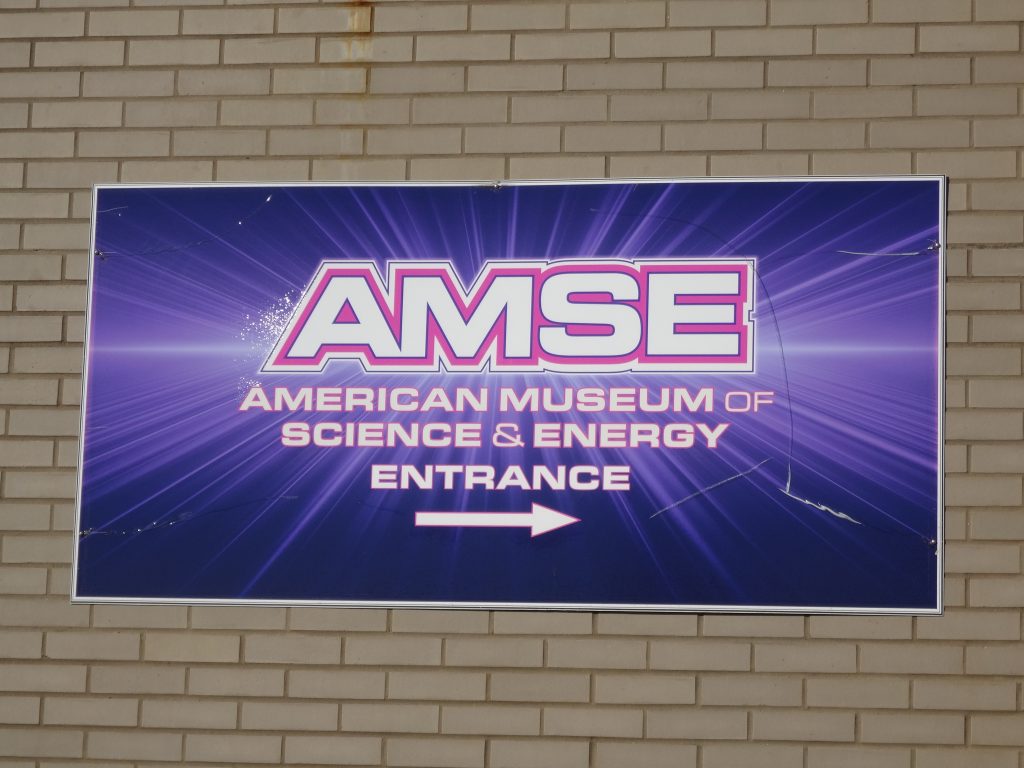 Located in Oak Ridge, TN, the American Museum of Science and Energy was initially founded in 1949 as the American Museum of Atomic Energy. At first, the Museum focused on the peaceful uses of atomic energy. Over time, it has broadened its scope to include exhibits on the history of Oak Ridge National Laboratory and multiple types of energy.
Located in Oak Ridge, TN, the American Museum of Science and Energy was initially founded in 1949 as the American Museum of Atomic Energy. At first, the Museum focused on the peaceful uses of atomic energy. Over time, it has broadened its scope to include exhibits on the history of Oak Ridge National Laboratory and multiple types of energy.
AMSE will relocate in fall of 2018 to a new site, and new permanent exhibits will be unveiled. At its past location, permanent exhibits at AMSE included “The Story of Oak Ridge,” featuring historic artifacts relating to the Manhattan Project and the building of the city, “Y-12 and National Defense,” and “World of the Atom.”
AMSE partners with the U.S. Department of Energy to offer public bus tours of the Oak Ridge facilities. The bus tour features the Y-12 New Hope Visitor Center, which includes displays on Manhattan Project and Cold War history; the X-10 Graphite Reactor, the Manhattan Project’s pilot plutonium production reactor, at Oak Ridge National Laboratory; and the site of the former K-25 plant, which used gaseous diffusion to enrich uranium for the Little Boy bomb.
Children’s Museum of Oak Ridge
Permanent Exhibits
The Children’s Museum of Oak Ridge has exhibits on such diverse subjects as 1930s schoolrooms, Native Americans in East Tennessee, the rainforest, and railroads. Two of its exhibits engage with the local history of Oak Ridge as it relates to the Manhattan Project in an age-appropriate way for children, including many artifacts from the period. The headquarters of the Oak Ridge Unit of the Manhattan Project National Historical Park is located in the Children’s Museum.
K-25 History Center
Permanent Exhibits
The K-25 History Center is currently under construction. It is slated to open in 2019, with the goal of preserving the history of the K-25 gaseous diffusion plant in Oak Ridge. The original K-25 plant was demolished by the Department of Energy (DOE), so the center will be on the second floor of Oak Ridge’s Fire Station Number 4 in East Tennessee Technology Park. It will include oral histories, a theater, and a few hundred artifacts. Though the K-25 History Center is currently under construction, DOE has launched a virtual museum website which “tells the story of the K-25 facility and its contributions to defense, energy and technology advancements through the 1990s.”
Utah
Historic Wendover Airfield Museum
Permanent Exhibits
The Wendover Air Force Base in Utah was the initial training ground for the 509th Composite Group, the weapon delivery arm of the Manhattan Project, in 1944-45. The Historic Wendover Airfield Museum chronicles this history, and strives to “re-create authentic exhibits and displays in order to stimulate a living connection between the visitor and the past.” The museum is engaged in restoring the Airfield’s buildings, and offers tours of the atomic bomb loading pit, the Enola Gay Hangar, and other sites. It also operates a YouTube page.
Virginia
The National Air and Space Museum Steven F. Udvar-Hazy Center
Permanent Exhibits
 Located in Chantilly, VA, the Udvar-Hazy Center is the companion to the National Air and Space Museum on the National Mall in DC. It has two large hangars, allowing for the display of large aircraft. On display at the Udvar-Hazy Center is the Enola Gay, the Boeing B-29 that dropped the “Little Boy” bomb on Hiroshima. The Enola Gay underwent an extensive restoration process that began in 1984.
Located in Chantilly, VA, the Udvar-Hazy Center is the companion to the National Air and Space Museum on the National Mall in DC. It has two large hangars, allowing for the display of large aircraft. On display at the Udvar-Hazy Center is the Enola Gay, the Boeing B-29 that dropped the “Little Boy” bomb on Hiroshima. The Enola Gay underwent an extensive restoration process that began in 1984.
The exhibition of the Enola Gay has proven controversial. The National Air and Space Museum planned to put the plane on exhibit in 1995. The initial script for the exhibit, called “The Crossroads: The End of World War II, the Atomic Bomb and the Origins of the Cold War,” included a discussion of the decision to use—and the consequences of using—the bomb. After protests by the Air Force Association and various veteran groups, the museum drastically shrank the section on the legacy of the bomb.
This sparked a new wave of criticisms from Japanese groups and others who thought the revised script engaged in “historical cleansing.” In the face of criticism from both sides, the museum ultimately decided to replace the planned exhibition with a simple display of the fuselage with little historical context. Still, numerous historians and scholars protested the exhibit.
Nonetheless, the exhibit ran until 1998, proving to be one of the most popular special exhibitions in the history of the museum. The Enola Gay went on permanent exhibition at the Udvar-Hazy Center when it opened in 2003. This exhibition ignited controversy once again, with protests from Japanese survivors of the bomb and others. Two men were arrested for throwing red paint, to symbolize blood, on the plane in 2003.
Washington, D.C.
National Building Museum
Temporary Exhibit: May 2018-March 2019
The National Building Museum in Washington, D.C., founded in 1980, focuses on architecture and the built environment as a window into understanding history. In May 2018, a temporary exhibit opened called “Secret Cities: The Architecture and Planning of the Manhattan Project.” The exhibit emphasizes the architectural ingenuity and intensive planning necessary for the construction of three new cities in a very short time frame. It also discusses other themes such as how segregation was designed into the new communities.
The exhibit situates the wartime buildings of Oak Ridge, Hanford, and Los Alamos within the modern architectural movement, particularly Bauhaus, and examines how these lofty principles played out in everyday life in these communities. It explores how these communities were early precedents for postwar suburban development, and how they changed after the end of the Manhattan Project. The exhibit runs through March 3, 2019.
Smithsonian National Museum of American History
Past Exhibit: 1994-2011
Over the years, numerous museums have engaged with the history and challenges of the Atomic Age in temporary, but impactful, exhibits. At the Smithsonian National Museum of American History in Washington, D.C., a long-running exhibit called “Science in American Life” addressed the “mobilization of science for World War II and atomic bomb research in the Manhattan Project,” among other topics such as biotechnology, environmental damage, and computing. This exhibit ran from 1994 to 2011.
Washington State

The B Reactor National Historic Landmark
Permanent Exhibits
The B Reactor (pictured at right) was the world’s first industrial-scale nuclear reactor. Located at the Hanford Site near Richland, the B Reactor produced plutonium for the Manhattan Project and operated until 1968. Today, the reactor is part of the Manhattan Project National Historical Park. The Department of Energy partners with the National Park Service to offer free public tours of the B Reactor. The tours are seasonal and usually offered between May and November.
The Hanford Reach Interpretive Center
Permanent Exhibits
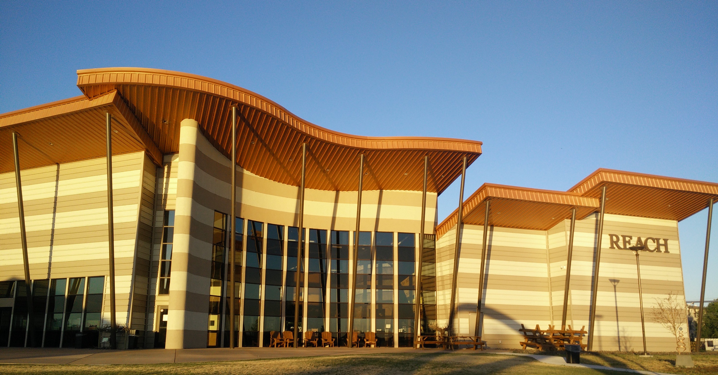
Since the opening of the REACH (pictured left) in 2014, the interpretive center has focused on the geology and history of the Columbia Basin region in the state of Washington. Before the opening of the REACH, the Columbia River Exhibition of History, Science and Technology (CREHST) detailed nuclear science and history, relating in particular to the Hanford project. Since CREHST has closed, the REACH has addressed the region’s nuclear history with two exhibits: “The Manhattan Project,” which pays particular attention to the role of the Hanford Engineer Works, and “Tri-Cities, Hanford, and the Cold War,” which follows developments in Hanford between the end of World War II and the fall of the Berlin Wall.
The REACH runs tours of multiple attractions in the region, such as vineyards and natural landforms. One of their offerings is a “Cold War Bus Alphabet House Tour,” which brings visitors on a refurbished 1950s bus to view the homes constructed in Richland during the Manhattan Project and Cold War. The tour is led by local historian Richard Nordgren.
The REACH also offers a variety of educational programming relevant to the Atomic Age, including field trips and classroom outreach visits. The REACH offers a lesson on “Pioneers of the Atom,” which focuses on “physics, atomic age artifacts, WWII and the Cold War,” and another called “Cleanup,” which tackles issues of radiation waste management.
The Northwest African American Museum
Past Exhibit: 2015-2016
The Northwest African American Museum in Seattle ran an exhibit in 2015 and 2016 called “The Atomic Frontier: Black Life in Hanford, WA.” The exhibit focused on African-American experiences and contributions to the Manhattan Project. It included accounts of racism, discrimination and segregation at Hanford Engineer Works, and charted the development of the black community in the Tri-Cities region after the war.
The Wanapum Heritage Center
Permanent Exhibits
The Wanapum Heritage Center, located next to Priest Rapids Dam, opened in 2015. The Wanapum used to live in the Hanford area until General Leslie Groves chose it for the Manhattan Project’s plutonium production site. The United States government forced local residents, including the Wanapum, to relocate within ninety days. White residents were given some small compensation for their property; Native Americans received nothing and were barred from the lands they had used for centuries.
The Wanapum Heritage Center is open to the public seven days a week and admission is free. It includes exhibits on the Wanapum and their culture, traditions, and beliefs, such as the film “Life as a Wanapum”. Temporary exhibits in 2018 include “Patriot Nations: Native Americans in Our Nation’s Armed Forces” and a special exhibit on the Ancient One (popularly known as Kennewick Man).





